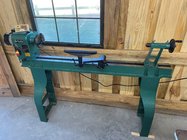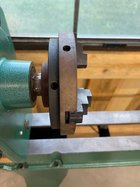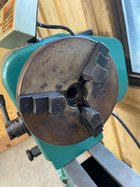Hello,
I'm new to woodturning and I recently bought a used Grizzly GO462, shown in the attached photo. The previous owner put a 3-jaw chuck on it and I've read that these chucks are intended for metal working, not wood. Is this true? Is it safe to use for woodworking? It appears that the chuck jaws are adjusted and tightened by rotating the two halves using two round keys in the provided holes. Any tips or instructions on using the chuck would be appreciated. I think two phillips screwdrivers will work, but I'm curious to know what the intended chuck keys look like so I can make one or buy one. Lastly, I need to get my bench grinder set up to sharpen my tools. The lathe was sold with a set of Steelex tools. Is this a good brand? What kind of wheel should I buy for sharpening them? CBN?
I'm new to woodturning and I recently bought a used Grizzly GO462, shown in the attached photo. The previous owner put a 3-jaw chuck on it and I've read that these chucks are intended for metal working, not wood. Is this true? Is it safe to use for woodworking? It appears that the chuck jaws are adjusted and tightened by rotating the two halves using two round keys in the provided holes. Any tips or instructions on using the chuck would be appreciated. I think two phillips screwdrivers will work, but I'm curious to know what the intended chuck keys look like so I can make one or buy one. Lastly, I need to get my bench grinder set up to sharpen my tools. The lathe was sold with a set of Steelex tools. Is this a good brand? What kind of wheel should I buy for sharpening them? CBN?




